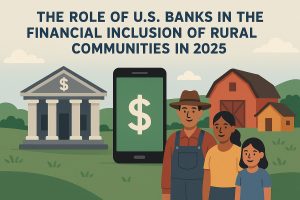Managing your finances in the digital age can feel daunting, especially with the overwhelming number of digital banks competing for attention in the US. Each promises enticing benefits such as unparalleled convenience, minimal fees, and cutting-edge features, but how do you decide which one truly meets your needs?
The answer lies in identifying a bank that aligns seamlessly with your financial goals and lifestyle, ensuring that managing your money becomes a source of stability rather than stress. Features such as low fees, intuitive mobile apps, and robust customer support can play a critical role in your decision-making process.
Understanding your financial needs

The first step to finding the best digital bank is understanding your personal financial goals. Are you looking for a no-fee account, access to a high-yield savings account, or seamless mobile banking? Prioritizing your needs helps narrow down the options and focus on banks offering services that align with your goals.
For instance, if you primarily need a checking account for daily transactions, prioritize digital banks with low or no fees, a user-friendly app, and robust customer support. Conversely, if saving for a big goal is your focus, look for high-interest savings accounts or investment options integrated into the banking platform.
Common financial needs to consider:
- Low fees: Avoid banks that charge monthly maintenance fees or ATM withdrawal fees.
- Savings potential: Opt for banks offering competitive annual percentage yields (APYs).
- Ease of use: Consider platforms with intuitive mobile apps and 24/7 access.
Understanding what matters most to you lays the groundwork for selecting a digital bank tailored to your lifestyle. By identifying your financial priorities, such as budgeting tools, savings incentives, or accessibility, you ensure a smoother experience that aligns with your goals and supports your long-term financial success.
Comparing account features
When comparing digital banks, it’s essential to focus on the unique features each one brings to the table. These features can significantly influence your overall banking experience, making it either seamless and efficient or cumbersome and frustrating.
Start by identifying tools and functionalities that simplify money management. For instance, many digital banks offer innovative expense tracking systems that categorize your spending, helping you monitor and control your financial habits effortlessly.
Automatic savings tools, such as rounding up transactions to the nearest dollar and transferring the difference into a savings account, can make building your savings more intuitive and less manual. These features encourage consistent savings habits without requiring significant effort, helping you accumulate funds over time.
Budgeting insights, often integrated into banking apps, provide visual breakdowns of your finances, empowering you to plan effectively. Real-time tracking of expenses and spending categories can help you identify areas to cut back and allocate resources more efficiently toward your financial goals.
By thoroughly evaluating these standout features, you can determine which digital bank aligns with your financial goals and offers tools that enhance your daily banking activities while promoting smarter financial decisions. A thoughtful approach ensures you select a bank that adds value and supports your financial well-being.
Here are some features worth evaluating:
- Fee structures: Transparent fee policies are a hallmark of reputable digital banks. Look for accounts with no hidden fees.
- Savings options: Some digital banks offer tools to automate savings, such as rounding up transactions to the nearest dollar and depositing the difference into a savings account.
- Bill payments and transfers: Seamless bill-pay options and quick transfers are essential for convenience.
- Cash-back rewards: A few banks provide cash-back incentives for purchases, offering added value.
By focusing on these critical features, you can distinguish the banks that cater to your needs from those that don’t. This comparison helps identify a provider that combines essential services with added perks.
Evaluating security and reliability
Security is an indispensable factor when selecting a digital bank, as it directly impacts the safety of your funds and personal information. In an era where cyber threats are becoming increasingly sophisticated, digital banks must implement advanced security protocols to ensure the utmost protection for their users.
Key measures to look for include industry-standard encryption, which safeguards your sensitive data during transactions, and two-factor authentication, which adds an extra layer of security by requiring a second verification step.
Additionally, verify that the bank is insured by the Federal Deposit Insurance Corporation (FDIC), ensuring your deposits are protected up to $250,000 in case of unexpected issues. FDIC insurance provides peace of mind and ensures your funds are safeguarded.
Beyond these technical features, consider the bank’s reputation for reliability and how effectively it responds to potential security concerns. By prioritizing a secure digital bank, you can confidently manage your finances without worrying about vulnerabilities or unauthorized access.
Security checklist for digital banks:
- FDIC insurance: Ensures your deposits are safe, up to $250,000.
- Encryption: Protects your personal information from unauthorized access.
- Fraud monitoring: Alerts you to suspicious activity in real-time.
- Reputation: Research customer reviews to gauge reliability and trustworthiness.
Additionally, consider the bank’s track record. Established digital banks with positive reviews and proven reliability are better equipped to handle unexpected challenges. A secure and trustworthy platform allows you to manage your finances with peace of mind.
Selecting the best digital bank in the US requires a thoughtful and informed approach. With a wide array of options available, understanding your unique financial needs becomes the first and most crucial step. A clear understanding of your goals ensures you focus on banks that meet your requirements.
Identifying what matters most—whether it’s low fees, user-friendly technology, or access to high-yield savings accounts—helps narrow your choices effectively. These priorities guide your decision and ensure a satisfying banking experience.
Comparing account features is equally important; evaluate fee structures, available tools for saving or budgeting, and any additional perks like rewards or cash-back programs. These comparisons allow you to choose a bank that aligns not only with your current needs but also with your long-term financial objectives.
Beyond convenience, the security of your funds and personal information should never be overlooked. Assess each bank’s security measures, such as FDIC insurance, encryption standards, and fraud monitoring, to ensure peace of mind.
Ultimately, the right digital bank can streamline your financial management, save money, and offer tools that simplify your daily banking needs. By making an informed decision, you empower yourself to take control of your finances with confidence and ease.






